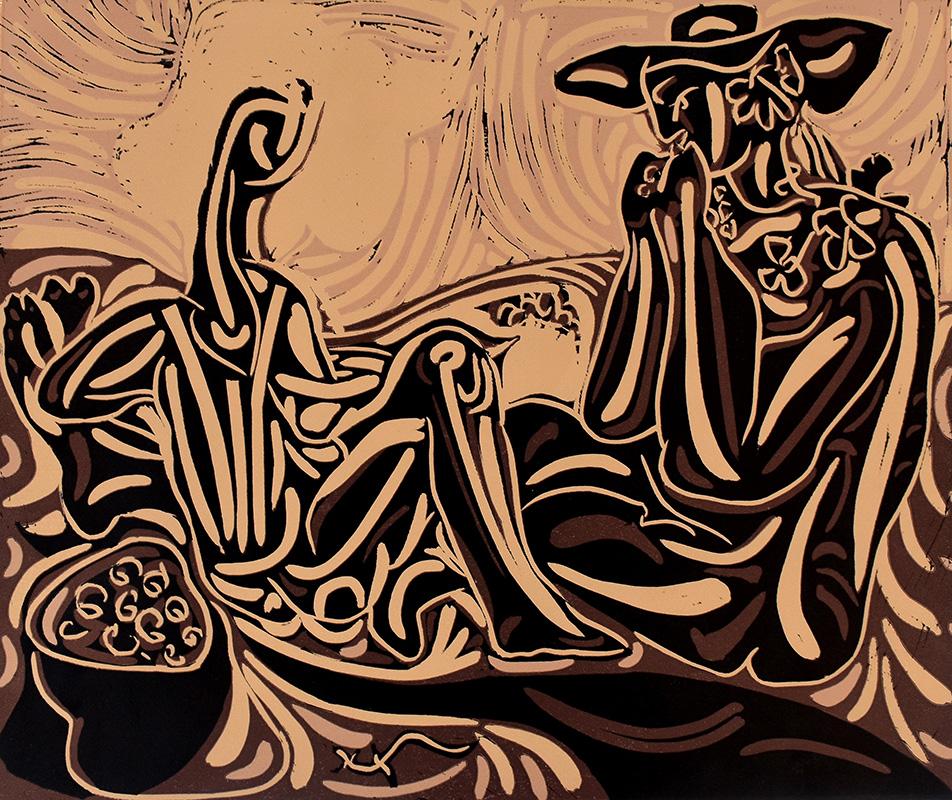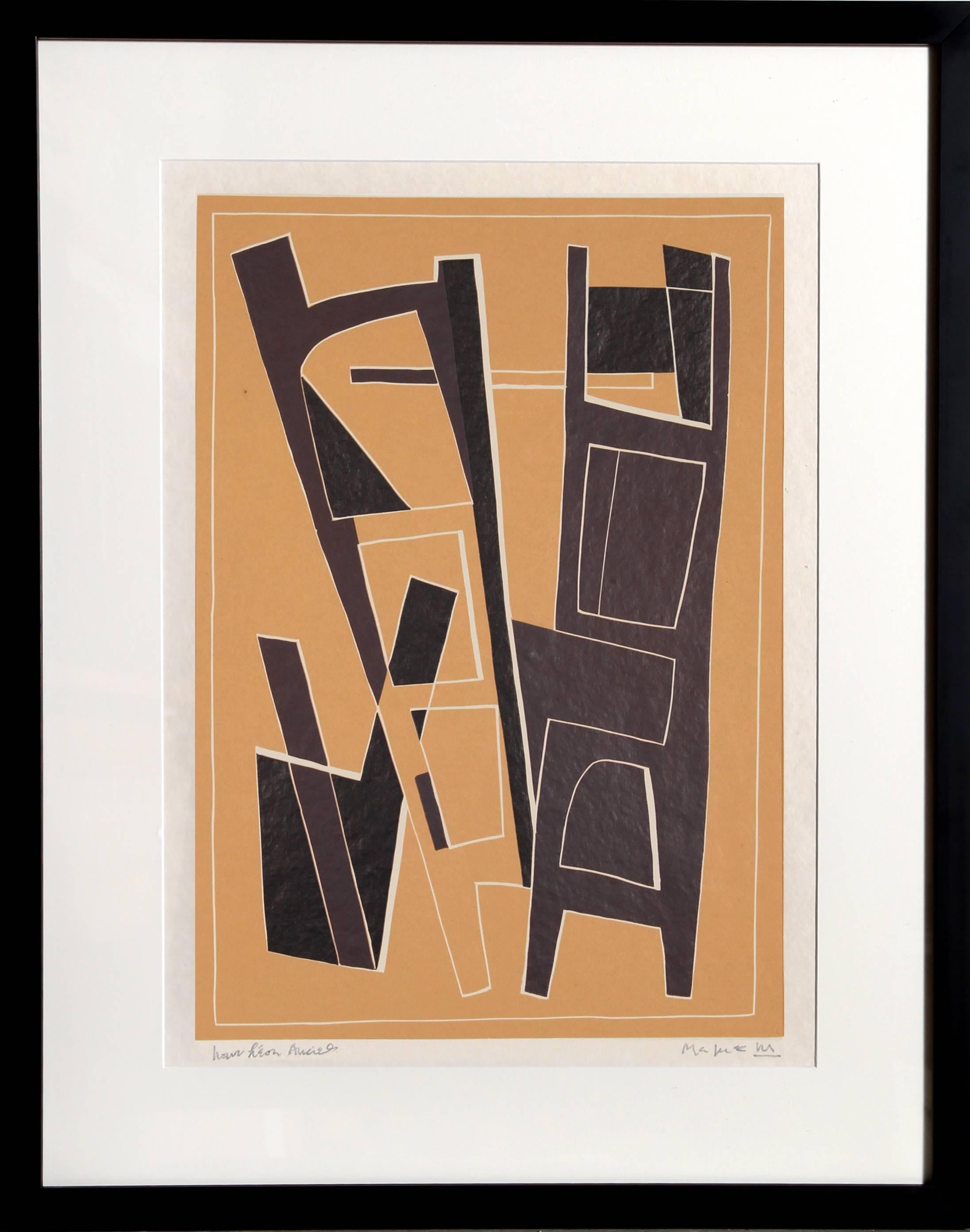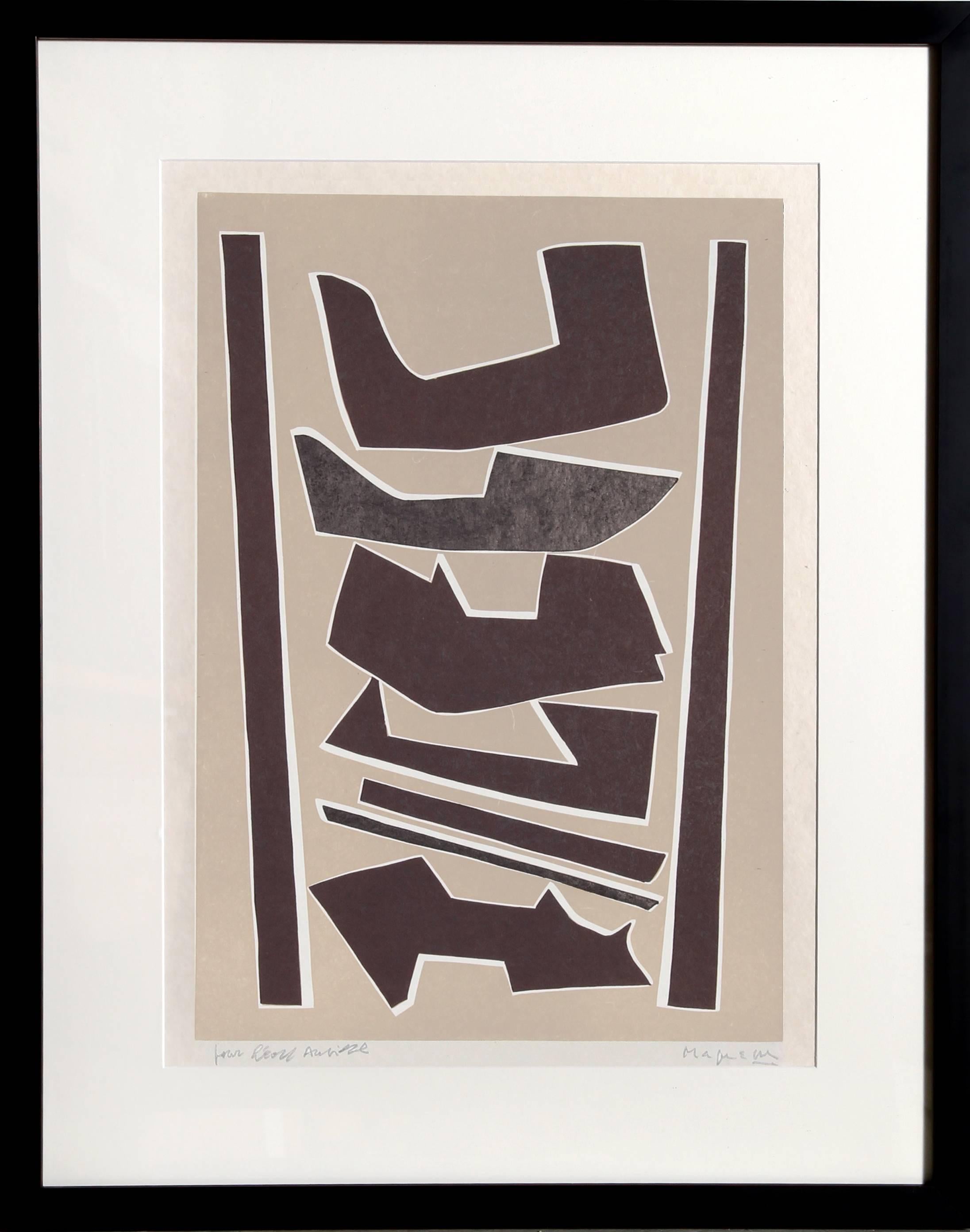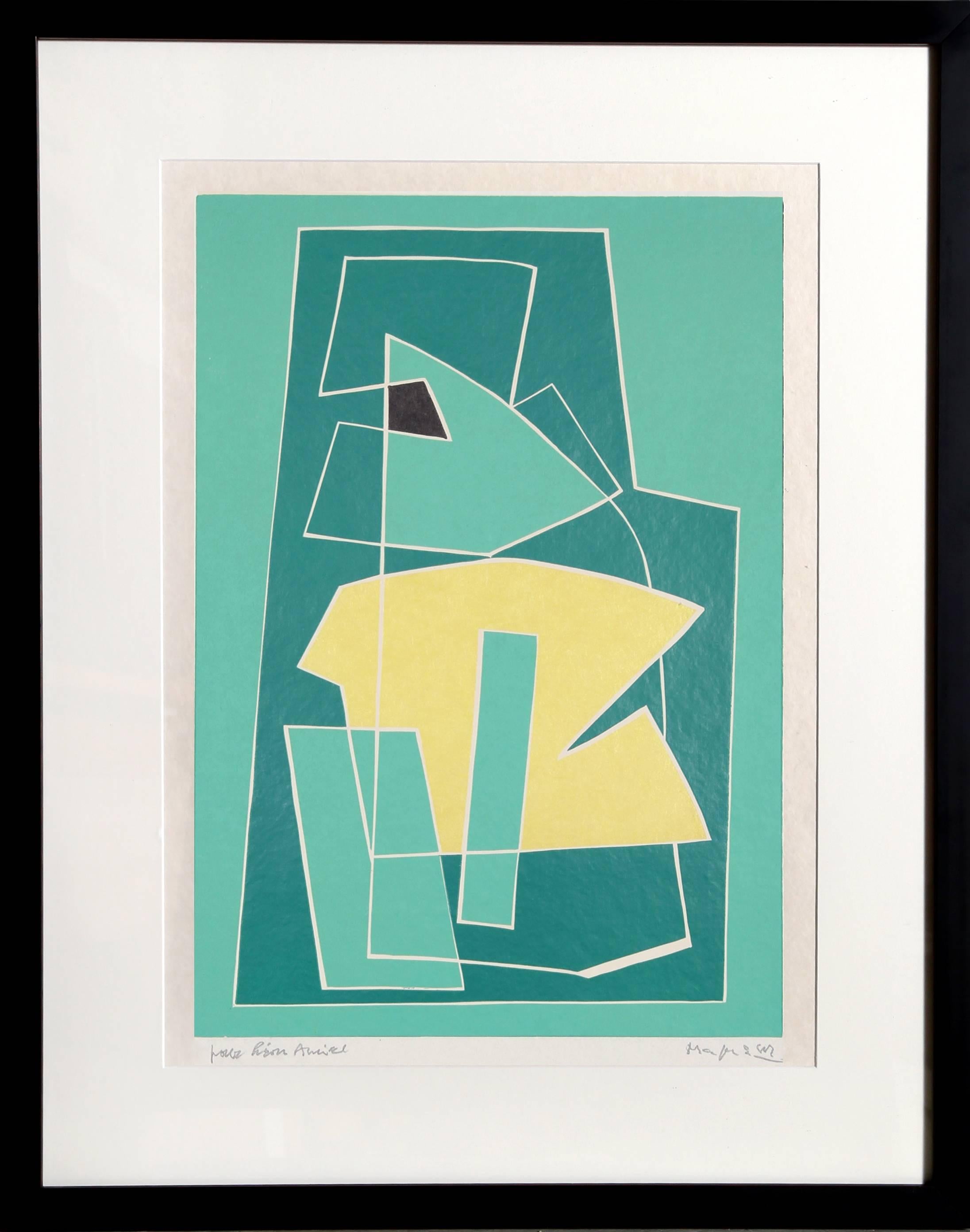Pablo PicassoCarnaval, Cubist Linocut by Pablo Picasso1967
1967
About the Item
- Creator:Pablo Picasso (1881-1973, Spanish)
- Creation Year:1967
- Dimensions:Height: 29.5 in (74.93 cm)Width: 24.5 in (62.23 cm)
- Medium:
- Movement & Style:
- Period:
- Condition:
- Gallery Location:Long Island City, NY
- Reference Number:
Pablo Picasso
One of the most prolific and revolutionary artists the world has ever seen, Pablo Picasso had a tremendous impact on the development of 20th-century modern art. Although he is best known for his association with the Cubist movement, which he founded with Georges Braque, Picasso’s influence extends to Surrealism, neoclassicism and Expressionism.
“Every act of creation is, first of all, an act of destruction,” the Spanish artist proclaimed. In Picasso's Cubist paintings, he emphasizes the two-dimensionality of the canvas, breaking with conventions regarding perspective, foreshortening and proportion. Picasso was inspired by Iberian and African tribal art. One of his most famous pre-Cubist works is Les Demoiselles d’Avignon (1907), a painting considered immoral and shocking at the time for its depiction of nude women whose faces resemble Iberian tribal masks.
Picasso made many portraits in this style, most often of the women in his life, their expressively colored faces composed of geometric shards of surface planes. In Woman in a Hat (Olga), 1935, he painted his first wife as an assemblage of abstract forms, leaving the viewer to decipher the subject through the contrasting colors and shapes. Picasso was a tireless artist, creating more than 20,000 paintings, drawings, prints, ceramics and sculptures. Tracing his life’s work reveals the progression of modern art, on which he had an unparalleled influence.
Browse an expansive collection of Pablo Picasso's art on 1stDibs.
- ShippingRetrieving quote...Ships From: Long Island City, NY
- Return PolicyA return for this item may be initiated within 7 days of delivery.
- VI from La Magnanerie de la Ferrage, Linocut on Rice Paper by Alberto MagnelliBy Alberto MagnelliLocated in Long Island City, NYArtist: Alberto Magnelli, Italian (1888 - 1971) Title: VI from La Magnanerie de la Ferrage Year: 1971 Medium: Linocut on Japon, signed in pencil Edition: Pour Leon Amiel Image S...Category
1970s Cubist Abstract Prints
MaterialsRice Paper, Linocut
- III from La Magnanerie de la FerrageBy Alberto MagnelliLocated in Long Island City, NYArtist: Alberto Magnelli, Italian (1888 - 1971) Title: III from La Magnanerie de la Ferrage Year: 1971 Medium: Linocut on Japon, signed in pencil Edition: Pour Leon Amiel Image ...Category
1970s Cubist Abstract Prints
MaterialsRice Paper, Linocut
- VI-2 from La Magnanerie de la FerrageBy Alberto MagnelliLocated in Long Island City, NYArtist: Alberto Magnelli, Italian (1888 - 1971) Title: VI-2 from La Magnanerie de la Ferrage Year: 1971 Medium: Linocut on Japon, signed in pencil Edition: Pour Leon Amiel Image...Category
1970s Cubist Abstract Prints
MaterialsRice Paper, Linocut
- II from La Magnanerie de la Ferrage, Linocut on Rice Paper by Alberto MagnelliBy Alberto MagnelliLocated in Long Island City, NYArtist: Alberto Magnelli, Italian (1888 - 1971) Title: II from La Magnanerie de la Ferrage Year: 1971 Medium: Linocut on Japon, signed in pencil Edition: Pour Leon Amiel Image S...Category
1970s Cubist Abstract Prints
MaterialsRice Paper, Linocut
- Cubist Composition, Lithograph by Will MentorBy Will MentorLocated in Long Island City, NYArtist: Will Mentor, American (1958 - ) Title: Cubist Composition Year: 1990 Medium: Etching and Aquatint, signed and numbered in pencil Edition: 13/75 Paper Size: 33.5 x 24 in. (8...Category
1990s Cubist Still-life Prints
MaterialsEtching, Aquatint
- Eye of the Peacock, Cubist Abstract Silkscreen by David PorterBy Edwin David PorterLocated in Long Island City, NYArtist: David Porter, American (1912 - 2005) Title: Eye of the Peacock Year: 1971 Medium: Silkscreen on Canvas mounted to paper, signed, dated, and numbered in pencil Edition: 193/2...Category
1970s Cubist Abstract Prints
MaterialsCanvas, Screen
- The Grape HarvestersBy Pablo PicassoLocated in London, GBPABLO PICASSO 1881-1973 Málaga 1881- 1973 Mougins (Spanish) Title: The Grape Harvesters Les Vendangeurs, 1959 Technique: Original Hand Signed and Numbere...Category
1950s Cubist Abstract Prints
MaterialsLinocut
- Still Life on a Table (Paris 1910)By Georges BraqueLocated in London, GBGEORGES BRAQUE 1882-1963 Argenteuil-sur-Seine, 1882-1963 Paris (French) Title: Still Life on a Table (Paris 1910) Nature morte sur une table (Paris 1910), 1910-11 Technique: Ori...Category
1910s Cubist Abstract Prints
MaterialsEtching
- Toro and HorseBy Ralston CrawfordLocated in Fairlawn, OHToro and Horse Lithograph, 1957 Signed and numbered in pencil by the artist. Titled in pencil lower left. Edition: 25 (24/25) Printer: Ravel, Paris Reference: Freeman L57.11 'Toro and Horse' was inspired by Spanish bullfighting...Category
1950s Cubist Prints and Multiples
MaterialsLithograph
- NU II: ONE PLATE FROM ESTAMPES ORIGINALES, ALBUM A (BLOCH 805)By Pablo PicassoLocated in Aventura, FLNu II: One Plate from Estampes originales, Album A (B. 805; Ba. 956). Drypoint, on Montval. Hand signed in red crayon by the artist. Edition of 20 (from the total edition of 70 wi...Category
1950s Cubist Abstract Prints
MaterialsPaper, Drypoint
- American Modernist Cubist Lithograph Screenprint "Reclining Woman" Max WeberBy Max WeberLocated in Surfside, FLReclining Cubist Nude Woman Max Weber (April 18, 1881 – October 4, 1961) was a Jewish-American painter and one of the first American Cubist painters who, in later life, turned to more figurative Jewish themes in his art. He is best known today for Chinese Restaurant (1915), in the collection of the Whitney Museum of American Art, "the finest canvas of his Cubist phase," in the words of art historian Avis Berman. Born in the Polish city of Białystok, then part of the Russian Empire, Weber emigrated to the United States and settled in Brooklyn with his Orthodox Jewish parents at the age of ten. He studied art at the Pratt Institute in Brooklyn under Arthur Wesley Dow. Dow was a fortunate early influence on Weber as he was an "enlightened and vital teacher" in a time of conservative art instruction, a man who was interested in new approaches to creating art. Dow had met Paul Gauguin in Pont-Aven, was a devoted student of Japanese art, and defended the advanced modernist painting and sculpture he saw at the Armory Show in New York in 1913. In 1905, after teaching in Virginia and Minnesota, Weber had saved enough money to travel to Europe, where he studied at the Académie Julian in Paris and acquainted himself with the work of such modernists as Henri Rousseau (who became a good friend), Henri Matisse, Pablo Picasso, and other members of the School of Paris. His friends among fellow Americans included some equally adventurous young painters, such as Abraham Walkowitz, H. Lyman Sayen, and Patrick Henry Bruce. Avant-garde France in the years immediately before World War I was fertile and welcoming territory for Weber, then in his early twenties. He arrived in Paris in time to see a major Cézanne exhibition, meet the poet Guillaume Apollinaire, frequent Gertrude Stein's salon, and enroll in classes in Matisse's private "Academie." Rousseau gave him some of his works; others, Weber purchased. He was responsible for Rousseau's first exhibition in the United States. In 1909 he returned to New York and helped to introduce Cubism to America. He is now considered one of the most significant early American Cubists, but the reception his work received in New York at the time was profoundly discouraging. Critical response to his paintings in a 1911 show at the 291 gallery, run by Alfred Stieglitz, was an occasion for "one of the most merciless critical whippings that any artist has received in America." The reviews were "of an almost hysterical violence." He was attacked for his "brutal, vulgar, and unnecessary art license." Even a critic who usually tried to be sympathetic to new art, James Gibbons Huneker, protested that the artist's clever technique had left viewers with no real picture and made use of the adage, "The operation was successful, but the patient died."[8] As art historian Sam Hunter wrote, "Weber's wistful, tentative Cubism provided the philistine press with their first solid target prior to the Armory Show." The Cellist...Category
Mid-20th Century Cubist Abstract Prints
MaterialsScreen
- Cin Cin - Etching by G. I Brook - 20th CenturyLocated in Roma, ITCin Cin is an original etching artwork realized by G. I Brook, Signed on the plate. In very good condition. Included a White Passepartout: 49 x 34 cm. The a...Category
20th Century Cubist Abstract Prints
MaterialsEtching
Recently Viewed
View AllRead More
Science Uncovers Hidden Truths behind Young Pablo Picasso’s Blue Period
From 1901 to 1904, Picasso limited his palette to bluish hues in producing some of his most famous early works. A new show looks at the recycled materials, hidden underpaintings, surprising influences and bohemian lifestyle that led to their creation.
Who Are the Most Popular Artists on 1stdibs?
Learn the stories of some of the world's most recognizable artworks and their makers.






